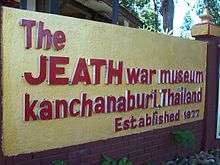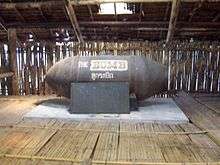JEATH War Museum
The JEATH War Museum (Thai: พิพิธภัณฑ์อักษะเชลยศึก) is a war museum in Thailand about the Death Railway built from 1942 to 1943 by Allied POWs under the direction of the Japanese, a part of the Thai-Burma railways.


Founding
The museum was founded in 1977 by the chief abbot of Wat Chaichumpol Venerable Phra Theppanyasuthee. It is located on the grounds of a temple at the junction of the Khwae Yai and Khwae Noi rivers in Kanchanaburi and it is a part of the famous The Bridge over the River Kwai saga.[1]
JEATH
The acronym JEATH stands for the primary nationalities involved in the construction of the railway: Japanese, English, Australian, American, Thai and Holland,[2] whereas the Thai name is Phíphítháphan Songkhram Wát Tâi (Wat Tai War Museum).[3]
The museum
The museum is divided into two sections, one depicting the construction of the Death Railway which is meant to recreate the quarters used by Allied POWs, and the other consisting of reconstructed bamboo huts containing such items as paintings, drawings and photos of and by former prisoners, weapons, tools, and maps.[4]
Tourist photos are not permitted in Section I of the museum.[4]
According to Wikivoyage, the JEATH Museum is considered an insult to those who suffered atrocities, noting the museum's inferiority to the Thailand–Burma Railway Centre in another part of the town.[5]
See also
References
- "The Jeath War Museum". Tourism Authority of Thailand (TAT). Archived from the original on 26 June 2015. Retrieved 18 May 2015.
- "JEATH War Museum - Kanchanaburi, Thailand". www.waymarking.com. Retrieved 22 October 2012.
- "JEATH War Museum". Lonely Planet. Archived from the original on 16 August 2012. Retrieved 22 October 2012.
- "Jeath War Museum". www.riverkwaibridge.com. Retrieved 18 August 2015.
- "Kanchanaburi". Wikivoyage. Retrieved 18 August 2015.
External links

- Webpage about the museum
| Wikimedia Commons has media related to JEATH War Museum. |